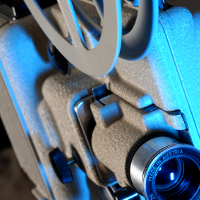The following post comes from Mandi Hart, a rising third-year law student at Antonin Scalia Law School, George Mason University, who worked as a video producer before going to law school.
 By Mandi Hart
By Mandi Hart
Movies are a first-love in America and around the world, and their production is made possible by the existence of intellectual property (IP) rights. Although most moviegoers may not recognize the vital role that IP plays in film, without it, screens would be dark. This post explains the critical role that copyright, trademark, and patents play in film production and financing.
Copyright is the Lifeblood of Movies
Copyright secures to creators certain exclusive rights in their original works of authorship, including rights of reproduction, distribution, public display, performance, and the creation of derivative works. These exclusive rights make it possible for creators and copyright owners to deploy their creative works as property rights in a free market.
Copyright’s exclusive right to distribute creative works is particularly important in the film industry. Distribution deals are essential to the filmmaking process, as many filmmakers finance the production of their movies by selling the exclusive right to distribute their film in a given territory. Distributors purchase these rights via a pre-sale, committing to pay a certain amount to the producer when the completed film is delivered in accordance with technical specifications. The pre-sale agreement serves as collateral for bank loans that provide actual cash for a film’s production. Once a film is completed and delivered, the payment from the distributor is then used to pay back the loan.
Without copyright, producers would have no distribution rights to sell in the first place, and without distribution deals, many producers wouldn’t be able to secure the funding necessary to make their movies.
Copyright also makes it possible for authors to option pre-existing works for adaptation into movies. An author or publisher can sell a film producer the right to create a derivative work from a novel, short story, play, or comic book. And films themselves might inspire derivative works—think of the breadth and popularity of Star Wars movies and shows today, 40 years after the original movie was released. Copyright not only protects the original creative works that often serve as the foundation for films, it also makes possible the many licensing deals that turn individual films into trilogies, series, or full-blown universes.
Copyright also fuels the music and sounds we hear in movies. From original scores and sound effects to the innumerable songs licensed for use in movies, copyright ensures that the people involved in the creation of movie sounds—whether artists, composers, or engineers—are incentivized and rewarded for their contributions.
By giving artists and creators a property right in the fruits of their artistic labor, copyright provides the foundation for the creation of movies as we know them today.
Trademark Helps Movies Get Made and Protects Their Brands
Just as copyright protects several aspects of any given film, trademark helps establish and protect a movie’s brand while providing supplemental sources of financing. As studios move away from traditional film financing mechanisms due to economic recession, consolidation within the industry, and risk-aversion in credit markets, a growing number of producers are looking for new funding sources. Product placement has become an increasingly common source of financing, providing mutual benefit to producers and marketers.
Featuring recognizable brands in a film enables a producer to leverage the reputation and public perception of certain products to craft characters and settings. Indeed, a character may become identified with a particular brand or product—think James Bond driving an Aston Martin, ET eating Reeses Pieces, or Carrie Bradshaw wearing Manolo Blahnik. A product may even become a character itself, as with the Wilson volleyball in Castaway.
The inclusion of known brands lends authenticity to the world of the film and the characters inhabiting it. When Mia asks Sebastian to get the keys to her Prius from a valet in La La Land, and Sebastian sees nothing but Prius key fobs on the valet stand, more is communicated to the audience than just the type of car Mia drives. Viewers get a sense of the world in which Mia lives, her friends and associates, and her subculture and values.
And of course, Prius benefits from the connection with an acclaimed film that won multiple Academy awards. While product placement represents a creative choice, it is also a shrewd business move for producers in need of funds and marketers looking for more subtle promotional opportunities than the traditional hard-sell advertisement.
Additionally, trademark serves to protect merchandise and ancillary products created in connection with a film. Marketing trademark-protected clothing, toys, home appliances, bedding, wallpaper, and other film-related merchandise is another critical source of revenue for producers, particularly those hoping to build a film franchise. Just as copyright is central to film financing and content, trademarks make an increasingly vital contribution to production funding and the creation of on-screen worlds.
But Without Patented Technology, Films Wouldn’t Exist
In addition to copyright and trademark, patents also play an essential role in film. A patented invention—the kinetoscope—allowed individual, consecutive images imprinted onto film to be projected in order and at speeds capable of creating the illusion of movement. Thomas Edison, holder of the kinetoscope’s patent, began documenting the world around him and created the first microdocumentaries for exhibition to paying customers. Across the Atlantic, the Lumiere brothers also embraced the possibilities that early film technology offered, creating short fiction films, the most enduring of which, Trip to the Moon, is still watched to this day.
The original film technologies, to both capture and display moving images, gave birth to a new form of leisure and entertainment. In less than three decades an entire industry had been established to exploit the commercial value of film and to satisfy the growing public appetite for movies.
Sound recording and playback technology revolutionized the industry and were followed just a few years later by technicolor, the debut of which—in The Wizard of Oz—changed filmmaking forever. Patented technologies created, then upended, the film industry, and to this day provide the foundation upon which advancements in filmmaking and viewer experience are based.
Just as the development of VistaVision in the 1950s gave directors more onscreen real estate and enabled sweeping scenic compositions, the implementation of Dolby Surround Sound in the 1980s allowed composers and sound editors to weave rich sonic tapestries. Composers were able to create complex filmic symphonies, and sound editors could immerse the audience more deeply into the world of the film by literally enveloping them in the movie’s aural field.
The switch from analog to digital, and the integration of computer technology into filmmaking, allowed for special effects unlike anything seen before. Computer-generated images put an end to an era of hand-drawn animation and manual splicing, as entire worlds could be created and manipulated digitally. Today, the development of 3D and virtual reality technology are set to revolutionize the film industry, changing the way images are captured and exhibited. Add to the distribution mechanisms numerous exhibition platforms (laptop, tablet, cell phone, etc.), and it is obvious the central role that patented technology plays in film creation and consumption.
Conclusion
In any given film, copyright, trademark, and patent play crucial roles in crafting the story, securing financing, and translating script to screen. Copyright secures property rights in (and incentivizes the creation of) original films as well as adaptations of prior works, while trademark contributes to the development of setting and characters. As an industry founded on patented technology, filmmaking relies on the innovation made possible by a patent system that encourages and incentivizes inventors. Those who developed sound recording and transmission technology, technicolor, panoramic projection, and many other innovations at the heart of moviemaking could not—and would not—have done so without the assurance that they would own the fruits of their innovative labor.
Next time you settle into a plush reclining chair, as the lights dim and the trailers begin, think about all the intellectual property embedded in the story you watch play out on-screen, because without it, that story wouldn’t exist.
 On February 16, 2017, CPIP hosted a panel discussion,
On February 16, 2017, CPIP hosted a panel discussion, 